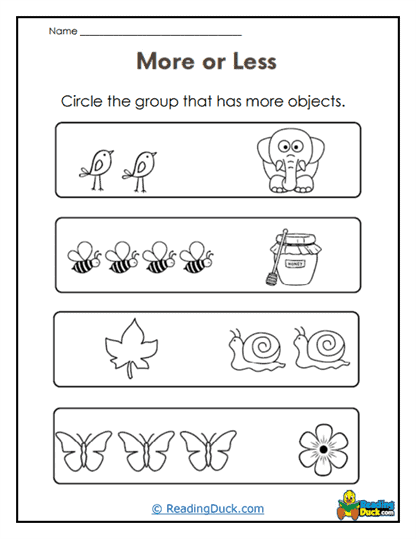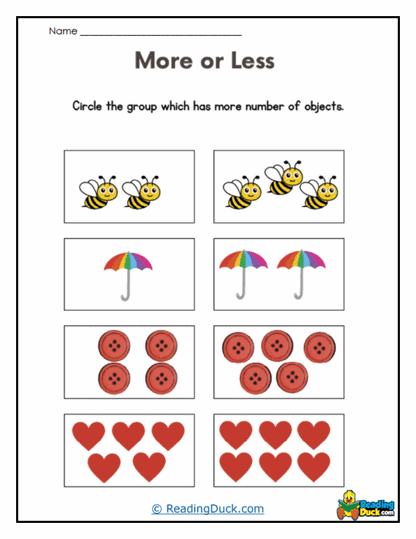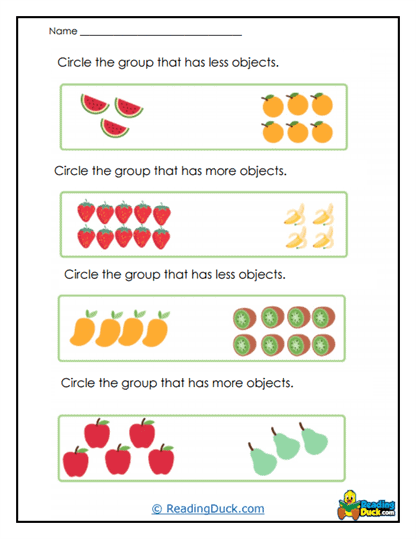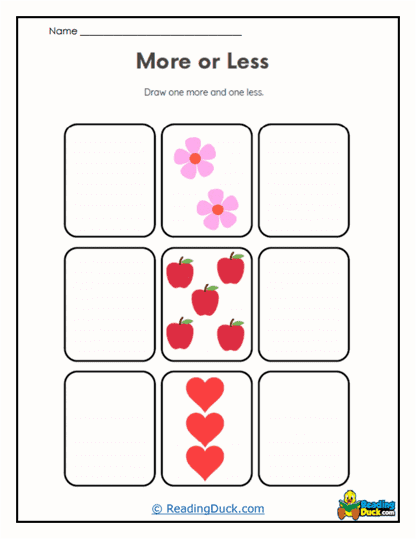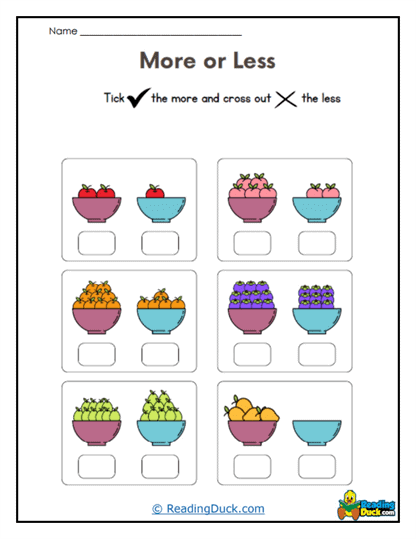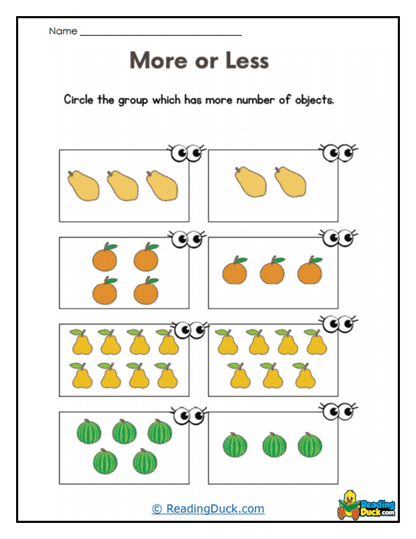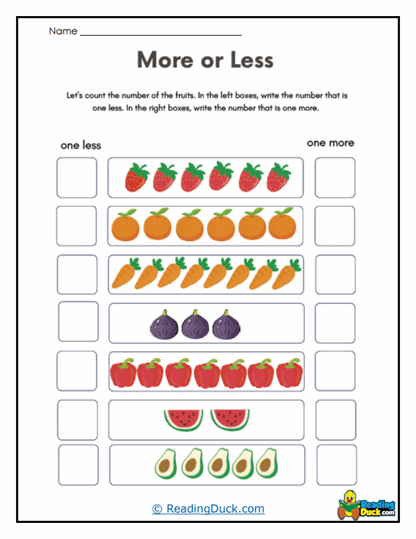More or Less Worksheets
About Our More or Less Worksheets
This worksheet collection is a vibrant, thoughtfully crafted resource designed to make learning about quantity comparison an enjoyable adventure. Each worksheet introduces students to new, visually appealing themes, from playful fish bowls and colorful fruits to charming seasonal icons and nature scenes. This variety captures students' attention and keeps them engaged, turning what could be a routine lesson into a fun exploration. These engaging visuals aren't just for show; they are carefully chosen to help students intuitively grasp concepts of "more" and "less," making math approachable and accessible.
The collection goes beyond just fun visuals by ensuring that each worksheet is structured to encourage independent learning. Designed with simplicity and clarity, these worksheets empower students to tackle tasks with minimal guidance, fostering confidence and independence. At the same time, they're perfect for collaborative learning experiences, making them a great fit for small groups or math centers. Teachers and parents can set these worksheets up for students to explore at their own pace or guide a class activity around them, offering a flexible approach that caters to various teaching and learning styles.
A standout feature of the collection is its range of difficulty levels, which makes it adaptable to different skill levels and learning stages. Teachers can introduce the concept to beginners with simpler worksheets, allowing students to count and compare small quantities before advancing to more challenging sheets. This progression helps students build confidence gradually, mastering foundational skills and preparing them for more complex comparisons. For homeschoolers, this collection provides a structured, incremental way to reinforce understanding, supporting learning at home in a way that is both effective and enjoyable.
In essence, the "More or Less" worksheet collection is a valuable asset for any educational environment. It combines engaging visuals, flexible teaching options, and a carefully layered approach to skill-building, ensuring that students not only understand the concepts but enjoy the journey. Teachers and parents alike appreciate these worksheets for their versatility, ease of use, and educational value. By making learning about quantity comparison fun and hands-on, this collection lays a strong foundation in early math skills, instilling confidence and curiosity in young learners as they progress in their educational journey.
Skills Developed
Attention to Detail
In a world filled with distractions, developing attention to detail is a valuable skill, and these worksheets are designed to hone it from an early age. As students carefully examine groups of objects to identify which has more or less, they engage in focused observation, sharpening their ability to notice subtle differences. This precision not only helps in mathematical contexts but translates to other subjects, like reading and science, where careful observation is key. By consistently engaging in these comparisons, students build a foundation of attentiveness that will benefit them in complex problem-solving, test-taking, and other academic tasks requiring a sharp eye and steady focus.
Visual Memory
Visual memory is crucial for learning and recalling information, and these worksheets are crafted to enhance this skill through engaging, repetitive patterns and recognizable images. When students remember and compare similar images across worksheets, they are strengthening neural pathways that support memory retention, a skill needed for everything from recognizing vocabulary words to recalling math facts. This practice of recalling images primes students for tasks requiring quick mental recall, helping them in reading, math, and even daily routines like remembering directions or following instructions. As students improve their visual memory, they become better equipped to handle the demands of a fast-paced learning environment where strong recall abilities are essential.
Concentration and Patience
In a digital age where attention spans are shrinking, worksheets that promote concentration and patience are invaluable for young learners. As students work through each activity, they need to focus on each detail without rushing, fostering a habit of perseverance and patience. This experience of sustained concentration is beneficial not only academically but also in life skills, as it teaches students that some tasks require time and careful attention. By building patience through these simple exercises, students learn to approach challenges with a calm, methodical mindset, preparing them for future tasks that require extended focus, like writing essays, conducting science experiments, or participating in group projects.
Problem-Solving
Learning to differentiate quantities and find solutions to simple math challenges is an excellent introduction to problem-solving. These worksheets subtly encourage students to think critically, as they analyze, count, and compare items to find the correct answer. This early exposure to problem-solving lays the groundwork for mathematical reasoning and logical thinking, essential skills for subjects like math, science, and even coding. By nurturing these skills in a low-stakes environment, students build confidence in their ability to approach and solve problems, setting them up for success in more advanced math concepts and real-life situations that require logical decision-making.
Real World Applications
Observation Skills
Observation is a foundational skill that students use in countless real-world scenarios, from reading maps and analyzing charts to spotting safety signs and understanding directions. By practicing “more or less” comparisons on these worksheets, students sharpen their ability to notice small differences and patterns, an ability that's crucial for interpreting information accurately. Teachers will find that as students improve in their observational skills, they become more detail-oriented in other areas, like identifying key facts in reading passages, distinguishing shapes in geometry, or interpreting scientific data. This ability to observe keenly translates into better critical thinking and analysis, equipping students to excel in activities that require a careful eye and thoughtful consideration.
Memory and Recognition Patterns
Visual memory and pattern recognition are powerful tools for learning, and these worksheets help students develop both in a playful yet effective way. Remembering the structure and quantity of objects on each worksheet aids in building memory retention, which is critical for tasks like recalling math facts, recognizing vocabulary words, or following instructions. For teachers, this translates into students who can more easily retain and retrieve information across subjects, creating a stronger foundation for academic success. Furthermore, pattern recognition enhances students' abilities to decode words in reading and identify trends in data, which are essential skills for future learning in subjects like statistics, language arts, and beyond.
Patience and Concentration
These worksheets are excellent for teaching students the value of patience and the power of focused concentration, skills that are harder to come by in a fast-paced, digital world. Completing each activity requires students to take their time, think carefully, and focus on the task at hand, building their ability to concentrate over longer periods. Teachers will notice that as students practice these skills, they become more resilient in tackling challenges, whether it's sitting through a lengthy test, completing a project, or participating in focused discussions. Developing patience and concentration early on sets students up for a range of future activities, like conducting science experiments, working in teams, or even engaging in hobbies that require dedicated practice, such as playing an instrument or coding.
Problem-Solving
Each comparison requires students to engage in early problem-solving, as they analyze the images, count objects, and make decisions based on what they observe. This process encourages them to think critically and systematically, building the foundations of mathematical reasoning and logical thinking. Teachers will see that as students become comfortable with this type of thinking, they approach other academic challenges, like word problems or hands-on science tasks, with greater confidence and skill. Problem-solving is an essential life skill that goes beyond academics, preparing students to tackle real-world situations, from managing budgets to planning activities, where they'll need to evaluate options and make decisions based on logical reasoning.
Numeracy and Quantitative Reasoning
Beyond the immediate task of determining “more or less,” these worksheets foster an understanding of numeracy and quantitative reasoning, giving students a practical foundation in math. Recognizing quantities, comparing groups, and counting objects in different arrangements lay the groundwork for more complex math skills, such as addition, subtraction, and even estimation. For teachers, this means students develop a more intuitive sense of numbers and quantities, which is not only beneficial in math but also in real-life situations, like measuring ingredients in recipes, comparing prices while shopping, or managing time effectively. This foundational comfort with numbers helps students build confidence in math, making them more prepared for advanced math concepts in later grades.
The Value of the Collection
Incorporating this worksheet collection into a teaching toolkit can be transformative for both educators and students. This engaging series goes beyond traditional math exercises, offering students a hands-on, visually stimulating way to build foundational skills that extend well beyond the classroom. As students work through these worksheets, they're not just learning to compare quantities or count objects-they're honing essential cognitive abilities like attention to detail, patience, and problem-solving, all of which are crucial for success across various subjects. By reinforcing these skills in a fun and accessible format, teachers are setting the stage for students to develop a solid, lifelong foundation in critical thinking and quantitative reasoning.
The real magic of the More or Less collection lies in its ability to make math feel approachable and enjoyable. Each worksheet presents concepts in a way that captivates young learners, transforming what could be dry math practice into an exciting exploration of the world around them. With themes ranging from nature to everyday objects, the collection taps into students' natural curiosity, making math feel relevant and meaningful. For students who might typically shy away from numbers, this accessible approach helps remove the intimidation factor, turning math into an adventure rather than a chore. By embedding essential math concepts within relatable scenarios, teachers are giving students a way to see math as part of their everyday lives.
The worksheets are more than just exercises-they are an invaluable tool for holistic development. Teachers and homeschoolers alike will appreciate how seamlessly these worksheets integrate with broader learning goals, supporting students in becoming observant, patient, and confident learners. The joy of learning is at the heart of this collection, helping students build a positive relationship with math that will carry forward into higher-level concepts and real-world applications. In bringing these worksheets into the classroom or home, educators are equipping students with the tools they need not only to succeed academically but also to grow as lifelong learners ready to tackle future challenges with curiosity and confidence.
